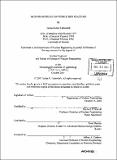MCNP4B modeling of pebble-bed reactors
Author(s)
Lebenhaft, Julian R. (Julian Robert), 1954-
DownloadFull printable version (17.72Mb)
Other Contributors
Massachusetts Institute of Technology. Dept. of Nuclear Engineering.
Advisor
Michael J. Driscoll.
Terms of use
Metadata
Show full item recordAbstract
The applicability of the Monte Carlo code MCNP4B to the neutronic modeling of pebblebed reactors was investigated. A modeling methodology was developed based on an analysis of critical experiments carried out at the HTR-PROTIEUS and ASTRA facilities, and the critical loading of the HTR-10 reactor. A body-centred cubic lattice of spheres with a specified packing fraction approximates the pebble bed, and exclusion zones offset the contribution of partial spheres generated by the geometry routines in MCNP4B at the core boundaries. The coated fuel particles are modeled in detail and are distributed over the fuelled region of the fuel sphere using a simple cubic lattice. This method predicted the critical core loading accurately in all cases. The calculation of control-rod worths in the more decoupled tall annular ASTRA core gave results within 10% compared to the reported experiments. An approximate method was also developed for the MCNP4B modeling of pebble-bed reactors with burnup. The nuclide densities of homogenized layers in the VSOP94 reactor model are transferred to the corresponding MCNP4B model with the lattice of spheres represented explicitly. The method was demonstrated on the PBMR equilibrium core, and used for a parallel study of burnup k- and isotopics on a single pebble. Finally, a study was carried out of the proliferation potential of a modular pebble-bed reactor for both normal and off-normal operation. VSOP94 analysis showed that spent fuel from pebble-bed reactors is proliferation resistant at high discharge burnup, because of its unfavourable plutonium isotopic composition and the need to divert -157,000 pebbles to accumulate sufficient 239Pu for a nuclear weapon. The isotopics of first-pass fuel pebbles are more favourable, but even more pebbles (-258,000) would be needed. However, a supercell MOCUP model was used to demonstrate that -20,000 pebbles would be needed if loaded with depleted uranium. But the associated reactivity loss would necessitate a compensatory increase in core height of approximately 50 cm. Such a change in core loading, as well as the properties of the special pebbles, would be noticed in a safeguarded facility.
Description
Thesis (Nucl.E. and S.M.)--Massachusetts Institute of Technology, Dept. of Nuclear Engineering, February 2002. Includes bibliographical references (v. 1, leaves 152-171).
Date issued
2002Department
Massachusetts Institute of Technology. Department of Nuclear Engineering; Massachusetts Institute of Technology. Department of Nuclear Science and EngineeringPublisher
Massachusetts Institute of Technology
Keywords
Nuclear Engineering.